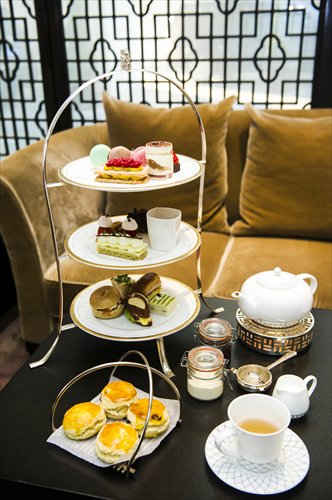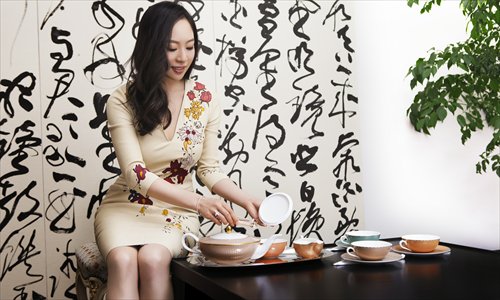HOME >> METRO BEIJING
Joining the tea party
By Li Ying Source:Global Times Published: 2014-1-16 19:38:01

An afternoon tea set including cupcakes, biscuits, pastries and Chinese tea wares. Some Beijing hotels serve afternoon tea that includes regional Chinese influences. Photo: Li Hao/GT
When Rory Slater took up his post as executive assistant food and beverage manager at The Ritz-Carlton Beijing, Financial Street, in summer of 2012, he made a telling first impression of afternoon tea served in the hotel's lobby. The silverware was polished, the tea tasted strong, but something was awry. The finger sandwiches, though dainty, left something to be desired with their arrangement.
"As an Englishman, wherever you go for afternoon tea it has to be authentic, particularly at a hotel," Slater, a tall Englishman, explained matter-of-factly in Received Pronunciation.
Anglophiles and aristocrats aren't the only ones in Beijing lured by the appeal of afternoon tea, a light meal traditionally served between lunch and dinner that originated among the wealthy elite of England in the 1840s.
As a throwback to a noble Victorian lifestyle more at familiar to the set of British period drama Downton Abbey, China's modern middle-class are increasingly answering the call for afternoon tea in the 21st century.

Rory Slater of The Ritz-Carlton Beijing, Financial Street. Photo: Li Hao/GT
Rich history
The custom of afternoon tea dates back to 1840 when the Duchess of Bedford Anna Maria Russell couldn't bear her hunger pangs late one afternoon. Lunch had been served early and dinner would not be ready until 9 pm, leaving Anna to request tea, bread and butter to satisfy her appetite.
Afternoon tea soon evolved in an upper-class institution in which women would wear elaborate gowns, gloves and hats. Tea, cakes and pastries were served using fine tea ware, bone china and delicate crockery. Little has changed since then, with the traditional afternoon tea set still featuring a selection of sandwiches, scones with jam and clotted cream, and pastries.
Raised in south London, Slater was introduced to the custom at an early age. "I started witnessing my grandmother prepare afternoon tea when I was a baby," he said.
Slater recalled his grandmother would prepare the light meal in the kitchen using a tea trolley with silverware ceremoniously polished beforehand. As soon as he was big enough, Slater would proudly push the tea trolley laden with tea wares, milk, crockery and pastries into the lounge to serve the family.
"Grandfather used to sit there with a pipe. My parents and two elder brothers would talk about everything and anything. This is where all my ideas about the service of afternoon tea come from," said Slater, who formerly worked as a chef at a London hotel.
Famed for its traditional afternoon tea, The Ritz Hotel London serves around 400 teas daily at weekends. Slater said his goal is to replicate the authentic English afternoon tea experience at The Ritz-Carlton Beijing, Financial Street and even draw a similar following.
Working with The Ritz-Carlton Beijing's chef, Slater said the pair had "played with sandwiches" and pastries to improve their presentation.
Recipes and portion sizes have also been altered, with warm raisin and plain scones being complemented by what Slater described as "more traditional" spreads of raspberry and strawberry jams.

Benson Sun, chef at the InterContinental Beijing Beichen.Photo: Li Hao/GT
Chinese variants
Benson Sun, executive chef at the InterContinental Beijing Beichen, has his own understanding about afternoon tea. Historically, afternoon tea was popularized in Hong Kong during the more than 150 years it was a British colony.
"The [afternoon tea] tradition adjusted as it made its way from the south to the north of China. Foods served with afternoon tea have varied based on local customs and culture," said Sun, adding that afternoon tea varies in Hong Kong, Guangdong Province and Shanghai.
In 2013, Sun reinvented the English custom by including both a Western- and Beijing-style afternoon tea set meal.
Both included dainty pastries and rich teas, with the Western one featuring doughnuts, lemon tarts, cupcakes and sandwiches, while the Beijing option boasted an array of local snacks, such as yellow pea cake, crispy barbecued pork buns and soy bean flour cakes.
"Girls love cupcakes, which is why we always include them," Sun said of the former afternoon tea set, which is most popular with nearby office workers.
Aside from five-star hotels, afternoon tea in Beijing is also served at functions and social events held at conference centers, golf clubs and private manors.
"We have received more orders for afternoon tea over the past two years than ever before," said Kevin Che, sales manager of Rata Catering.
Che said the catering company's clients comprise enterprises, particularly in the luxury goods sector, and individuals, such as entrepreneurs' wives who host private afternoon tea parties.
"Luxury car dealerships, such as Rolls-Royce, arrange afternoon teas for their test-drive events. They believe the air of nobility and elegance associated with afternoon tea suits their brand image," said Che.

The Ritz-Carlton Beijing, Financial Street, stays true to English tradition with its afternoon tea. Photo: Li Hao/GT

Sara Jane Ho, founder of finishing school Institute Sarita. Photo: Courtesy of Sara Jane Ho
Brushing up on etiquette
Sara Jane Ho hired a chef formerly employed at the French Embassy to provide afternoon tea at Institute Sarita, a finishing school she founded in Beijing in 2012 that teaches Chinese women the finer points of etiquette. The school serves afternoon tea to students at daily classes.
A Hong Kong native and Harvard Business School graduate, Ho studied for two months at a Swiss finishing school before she moved to China. On January 9, she went to Guangzhou, Guangdong Province, to teach a lesson on afternoon tea etiquette organized by a private bank for 50 women.
"Afternoon tea is becoming very popular among Chinese women now," Ho noted, adding that her school offers afternoon tea lessons as part of its hostess and debutante courses.
Ho said some challenges for Chinese in afternoon tea etiquette include confusion over which foods should be eaten with cutlery or fingers.
"Many Chinese will cut a scone with a knife or pick up a sandwich using a fork, which is incorrect. Scones should be broken by hand and sandwiches should be picked up using fingers," Ho explained.
"Another common mistake is made when eating a scone with jam and clotted cream. [Most Chinese] do not know to first spoon some jam and cream onto one's own plate before spreading it onto a scone using a tea knife. A third example is the teaspoon, which is sometimes incorrectly left in a cup when it should be placed on a saucer."
Chinese people's desire to master Western dining etiquette reflects the higher standards they are setting themselves, said Ho, who described this transition as a sign of social progress.
"Now that China is becoming an economic and political power on the global stage, Chinese need to better understand the rest of the world and let the world better understand China. On top of that, Chinese are adopting a higher quality of life. They have deeper desires, hold themselves to higher standards and want to earn the respect of others," she said. "Recent history in China has led to some lost culture and values, which we hope to bring back."
Tradition lives on
But whether traditional dining etiquette still matters today is a polarizing issue.
Fewer Westerners send children to finishing schools compared to past decades, which Ho attributes to etiquette education being taught at home. "There is a great emphasis on good manners being taught from parents to children," said Ho.
Slater insists tradition will always be at the core of afternoon tea, no matter where it is served in the world.
"English tea comes out very hot, which can crack a cold china cup. If you put milk in first, it helps dispense the heat and can avoid cracking. I thought this [idea] has sounded pretty good since childhood," he said. "By comparison, the French say you should add milk after [tea is poured], otherwise you spoil the flavor. Most people don't care about it, but it is tradition," he said.
Slater never turns down the chance to explain to guests at his hotel the reasoning behind afternoon tea traditions, ensuring the English custom continues to thrive and offer nourishment to those who, like the Duchess of Bedford more than 170 years ago, yearn for a classy bite to eat between lunch and dinner.
"Today, people are doing things quicker," sighed Slater, alluding to many people's preference for tea bags over tea leaves. "But I like talking with ladies and gentlemen over afternoon tea in the lobby to help them understand why we do certain things. I am keeping some of the elegance and formality, which threatens to be lost over time."
Posted in: Metro Beijing